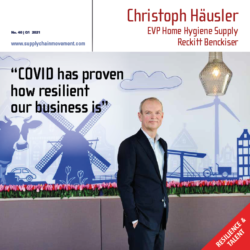‘Factor supply chain disruptions into your budget’

How can your company go about covering all the supply chain risks? And what does that mean for your budget? Solventure and Zencargo answered these questions during Dialogue Thursday. Alfred den Besten from Solventure advised professionals to take a critical look at their company strategy and customer segmentation: “You might accept greater risks for some customers than for others.”
By Marcel te Lindert
Many supply chains have been disrupted by the war in Ukraine. Alfred den Besten referred to the car manufacturers who are in trouble now that their Ukrainian supplier of wire harnesses has sent all employees home. Why didn’t the car manufacturers increase their safety stocks when they saw the growing threat of a Russian invasion? Why didn’t they find an alternative supplier sooner? And why didn’t that supplier increase its production sooner? “That would have undoubtedly resulted in higher purchase prices and other, more expensive supply routes. You have to factor that into your budget. In fact, companies don’t only need a safety stock but also a safety budget,” said the Vice President Sales & Marketing at Solventure.
To remain responsive, companies need to invest in supply chain visibility. Zencargo supplies the necessary technology for that. “Within six hours of the Ever Given blocking the Suez Canal, we were able to tell our customers which goods were stuck, right down to SKU level. We spent days modelling different scenarios. What if the hold-up lasts two days? Or a week? We couldn’t do much about the goods actually on the Ever Given. But perhaps there were identical goods somewhere else in the chain and they could be flown in. Visibility gives you the opportunity to keep your promises to customers,” explained Dave van Diggele, Business Development Manager at Zencargo.
Customer segmentation
When it comes to risk management, some risks are bigger than others. A brewer could find a solution to a disappointing grain harvest, but not to an unexpected problem in the supply of bottles. “You can’t just get them from somewhere else. So analyse the precise risks carefully,” Den Besten explained. “It’s also important to segment your customers. You might accept greater risks for some customers than for others. If a customer’s production will grind to a halt and you will be hit by hefty penalties if you can’t deliver, it’s important to eliminate every risk. The impact of a risk depends on multiple factors. Is it an established market or one you are building up? Do you face strong competition? Can customers fall back on other products?”
One new problem is the recently declared lockdown in a number of Chinese cities, including Shenzhen which is home to many consumer electronics manufacturers – so those goods flows are now at risk of coming to a standstill. Companies that will be affected by this want to know not only when factories will close, but also when they will reopen. “And when they do, what should they produce first? Are there any urgent orders that need to be picked up directly from the factory? Thanks to information about this, the users of our visibility platform can respond as effectively as possible,” said Thomas Dejalle who, like Van Diggele, is Business Development Manager at Zencargo.
Internal insurance
As Den Besten stated earlier in the session, uncertainty and unpredictability cost money. Backup plans cost money, so companies have to budget for disruptions such as the war in Ukraine, the Suez Canal blockage and the lockdown in Shenzhen. “In effect, that’s your internal insurance,” said Den Besten. He advised the use of flexible margins, with an upper and a lower limit. “At Solventure we always look at three factors: costs, cash and service. Which factor is most important for your company? If the focus is on service, you can factor in the costs of risks. If the problem doesn’t happen, you benefit from a financial windfall. But if you focus on costs, you may have to accept that you will lose a bit of your market share from time to time.”
Good risk management starts with the business strategy. Is the focus on maximum service levels, on minimum cost levels or on optimizing the cash position? “You can’t optimize all three factors at once,” stated Den Besten. “If your strategy is clear, first decide how many risks you are willing to take and then start talking to chain partners who can help you eliminate some of those risks. That costs money, but see it as an insurance premium – just as you would insure your house against fire. And remember, it’s impossible to take out insurance on a house that’s already burning.”
Resilience costs money
So in a nutshell, resilience costs money, and if you want to protect yourself against risks, you need to invest. But are companies prepared to do that? “That depends on who you talk to,” answered Den Besten. “The supply chain manager usually sees the need. But the question is whether he can also convince the people with ultimate responsibility for finance and operations. We notice that the senior executives don’t always realize just how complex the supply chain is and which major risks are involved. 80% of companies lack this awareness.”
Den Besten acknowledged that the importance of an effective supply chain has received more attention in the boardroom over the past two years. “It is being discussed a lot, but that’s as far as it goes. To return to the example of the burning house: the discussion revolves around which is the cheapest method of putting out the fire – water or foam. But that’s not the right discussion. It’s time for companies to take action and finally get serious about risk management.”










